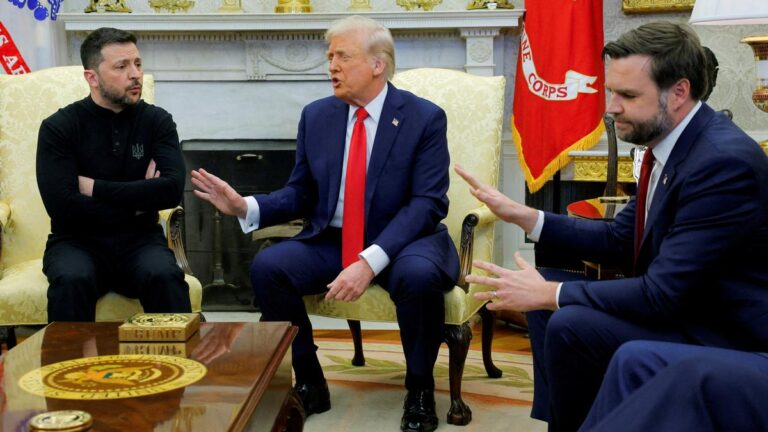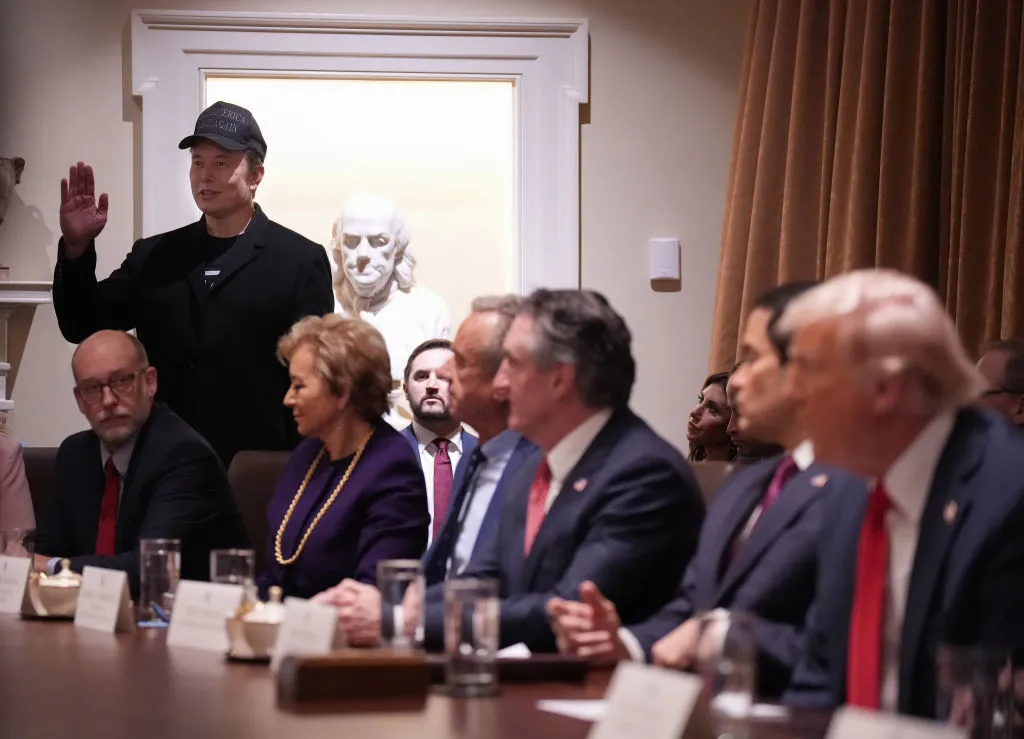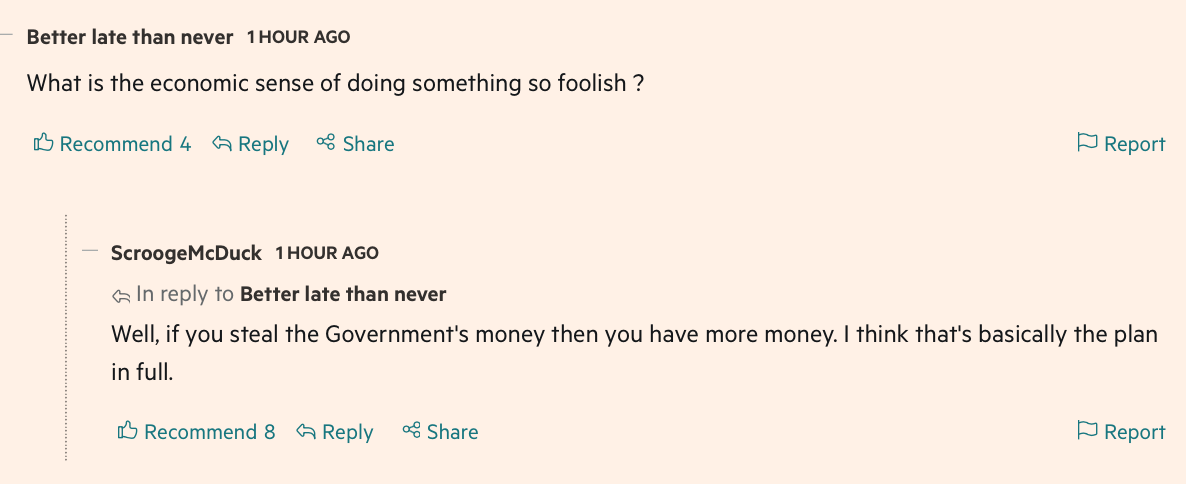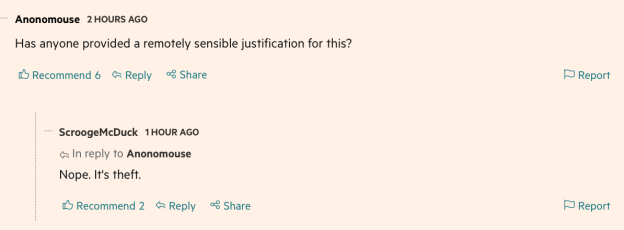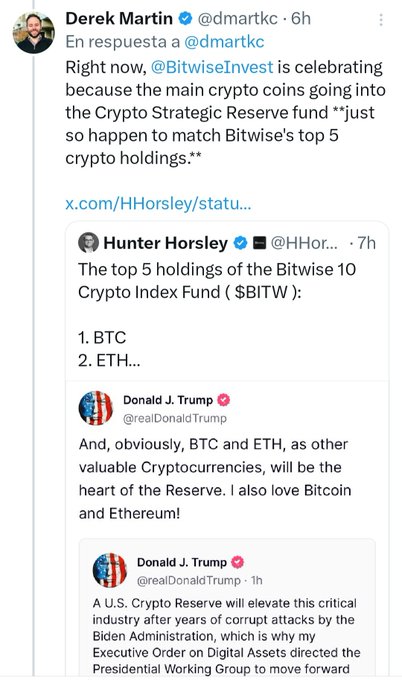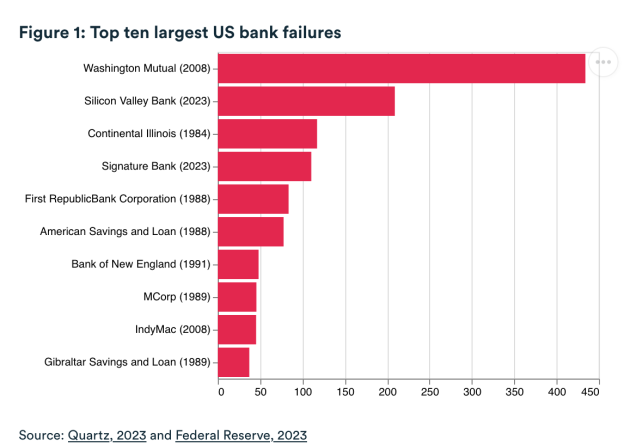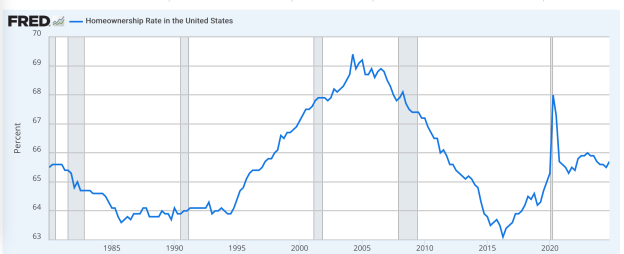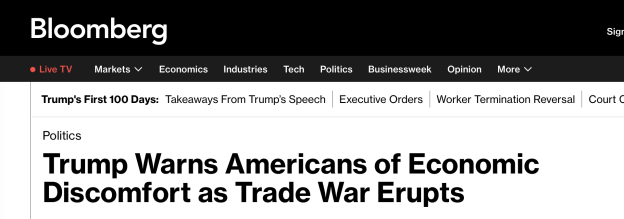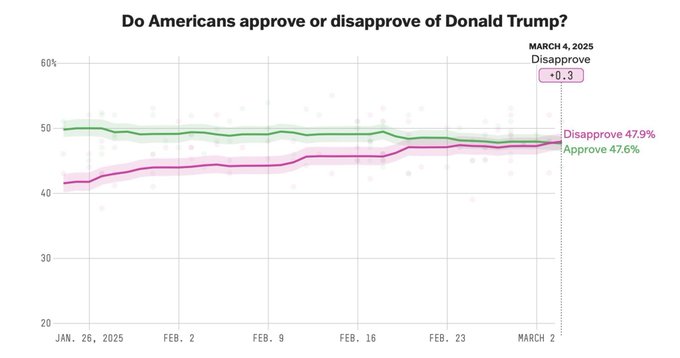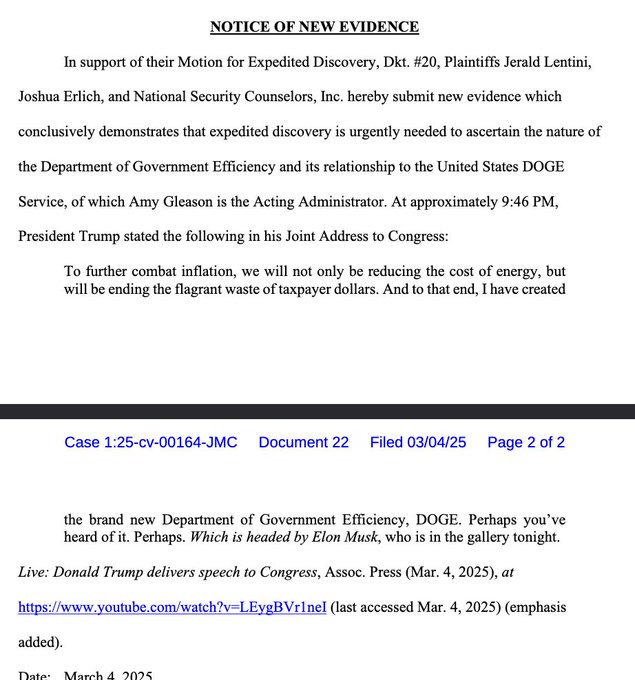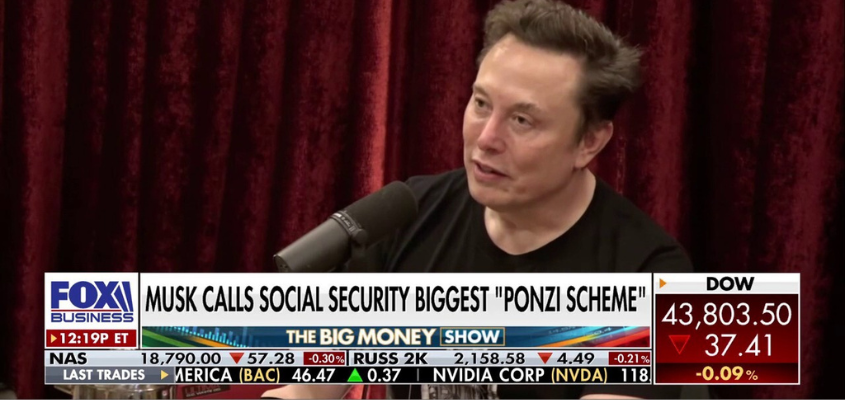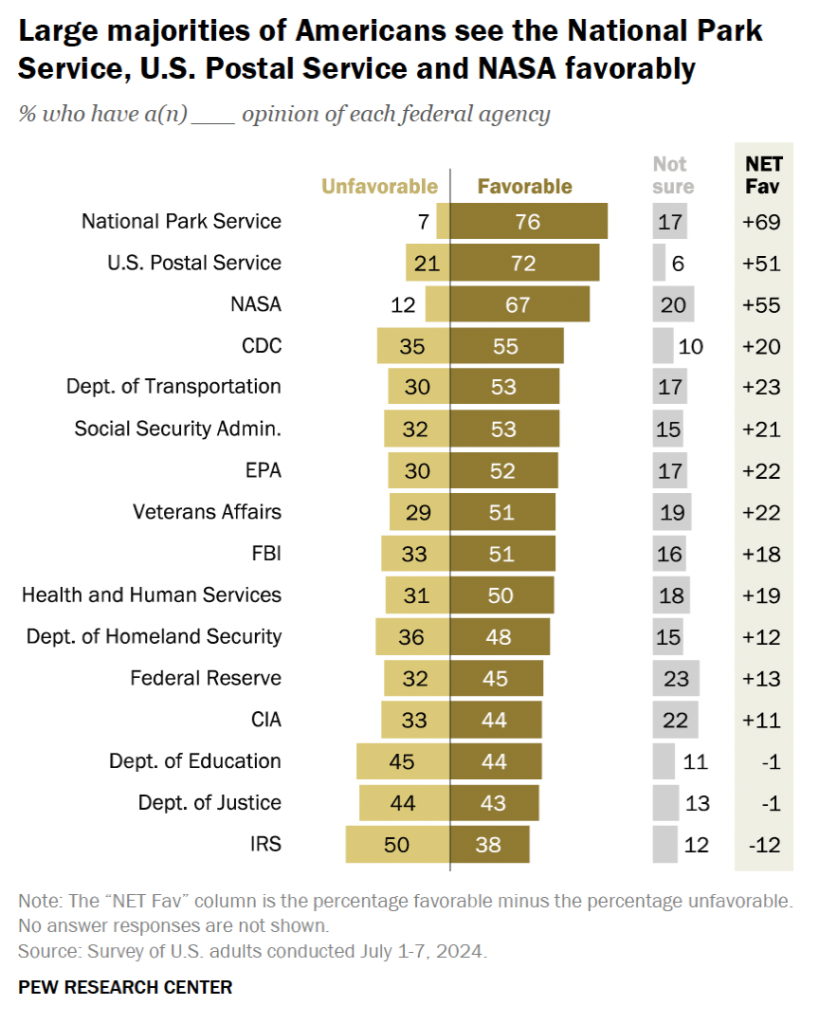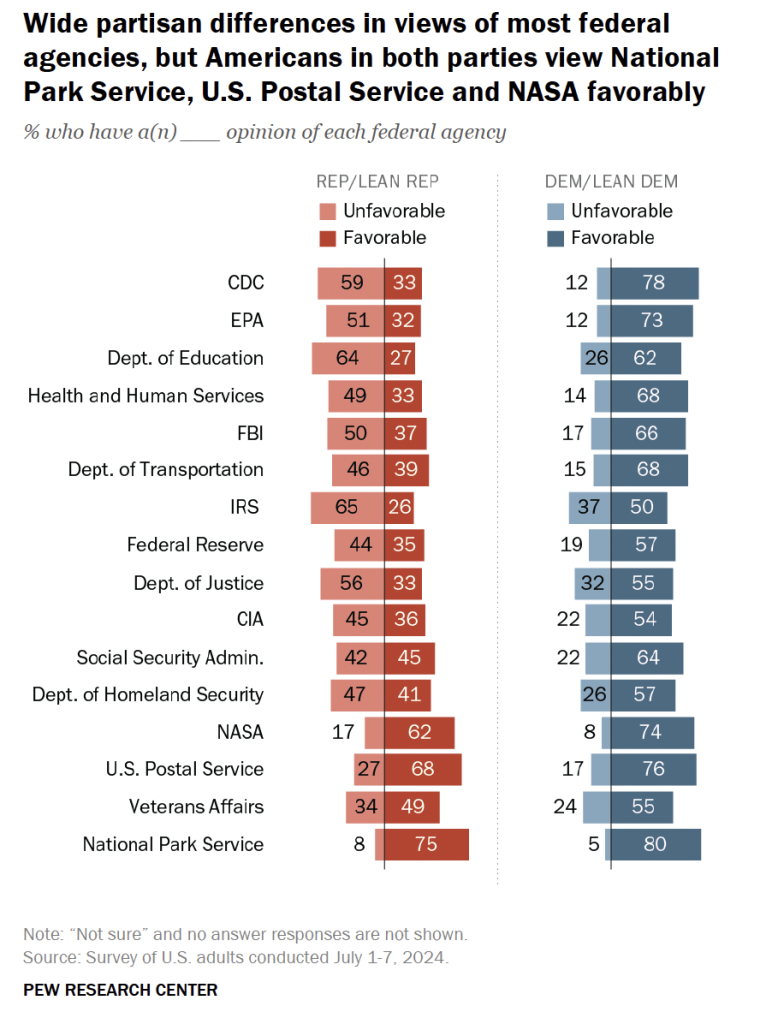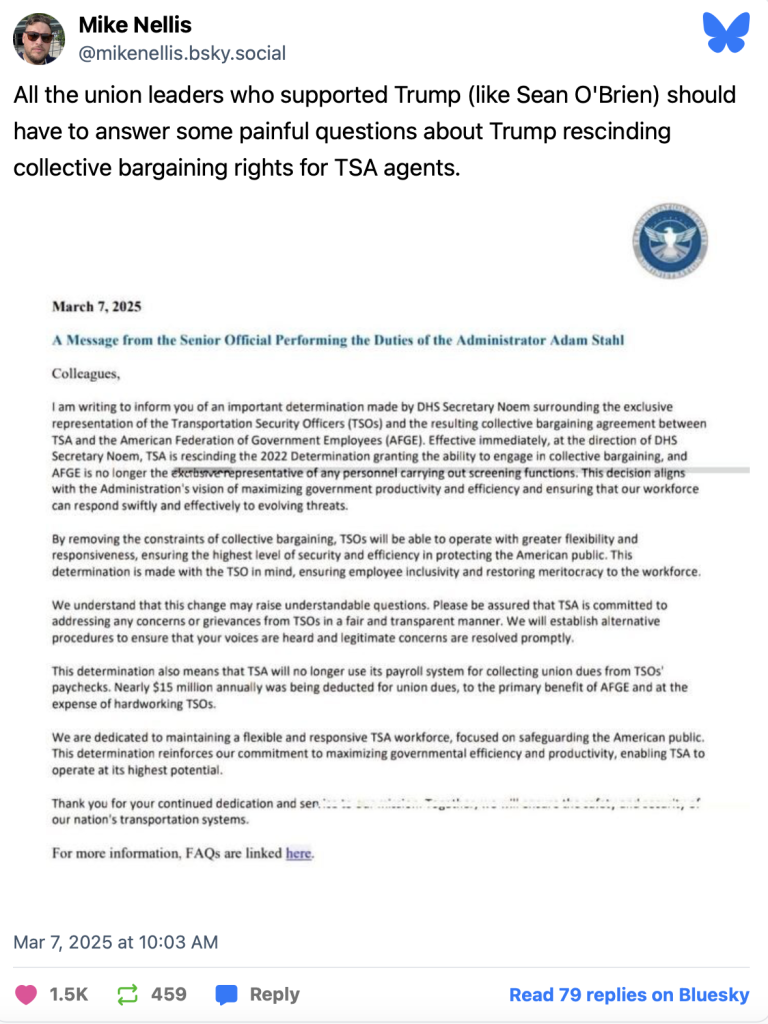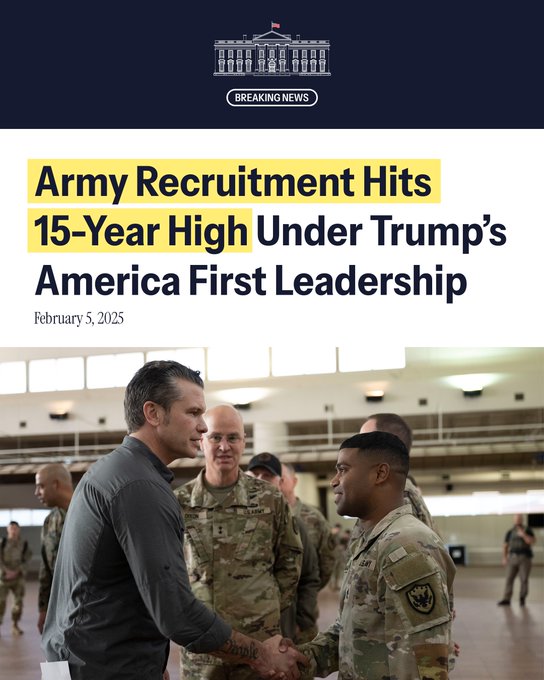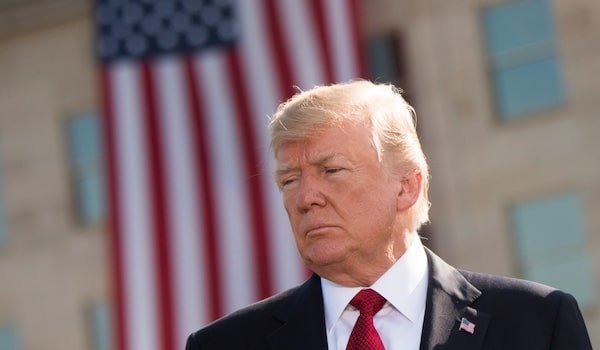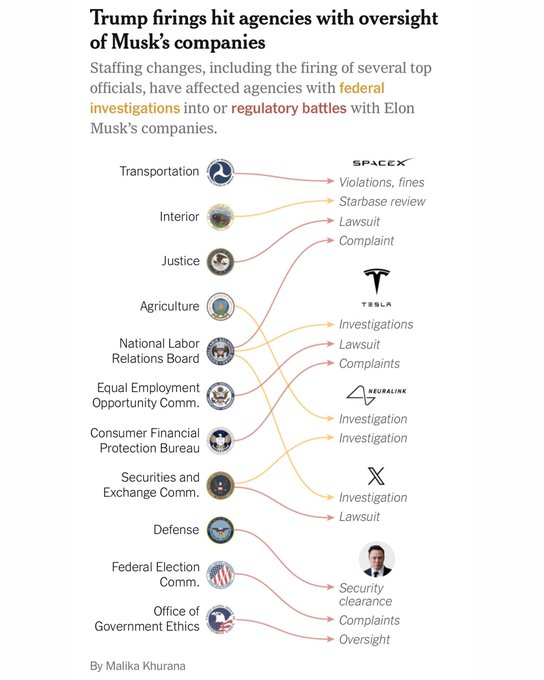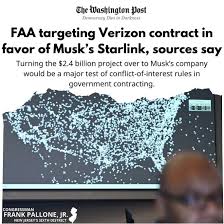NOTHING’S OVER BAR THE SHOUTING — THIS PODCAST EXPLAINS THE WARFIGHTING LIMITS OF TRUMP, STARMER, ZELENSKY

by John Helmer, Moscow @bears_with
Several hours before Vladimir Zelensky arrived at the Oval Office, Nima Alkhorshid led the discussion of each of this week’s negotiations on the Ukraine war by President Donald Trump, and by the only brain in the room, Vice President JD Vance.
Click for the hour-long podcast here. https://www.youtube.com/watch?v=RCGtyGgi7Ig
Follow the entire Oval Office press conference between Trump and Zelensky. This is as revealing of Trump’s limitations in negotiations as it is in exposing Zelensky’s vulnerabilities.
Note the pat which Vice President JD Vance reached out to give Trump in the last seconds of the session. That was the reassurance Vance knows Trump needs. As explained in the podcast, and also in this analysis, French President Emmanuel Macron also understands and displayed during his visit to the White House on Monday.
Quite another reassurance, without the hand pats, is understood in Moscow, as the podcast explains.
******
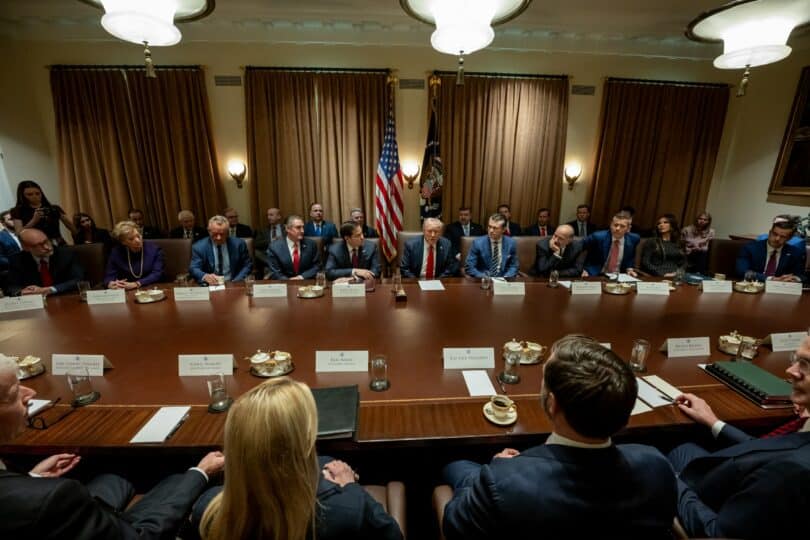
Donald Trump’s first cabinet meeting, 2025. Source: Wikimedia Commons.
Trump’s Nationalist Conservative White Christian Agenda
By Deborah Veneziale (Posted Feb 28, 2025)
Originally published: Guancha on February 27, 2025 (more by Guancha)
The Trump-orchestrated blitzkrieg exposition of a Nationalist Conservative White Christian Agenda (NCWCA) has recently shocked Europe. Outside the US, natural questions emerge: What are the internal contradictions within the US ruling class that have given rise to recent developments? What are the underlying changes within the base and superstructure of the United States? What are the long-term ideological and political consequences on US Foreign Policy? How should the Global South respond?
The following is a short note to help start addressing these questions. We begin by analyzing the forces surrounding the US Presidency and the US national security apparatus. Then, we examine some possible impacts on foreign policy.
The Trump Camp as of mid-February 2025
The Trump camp is conducting an exceptionally well-planned attack on significant parts of the US state apparatus (including the now explicitly fully sullied and exposed USAID) and is displaying its contempt for the European elite.
Trump now has an army of MAGA think tanks behind him.1 The America First Policy Institute (AFPI) and the Center for Renewing America (CRA) dominated the pre-inauguration planning and “Trump 47”, Trump’s agenda for his second presidency. Vought, Rollins, and Trump policy chief Stephen Miller all joined the Trump 2 administration. CRA and AFPI advocate far more aggressive uses of executive power to purge the bureaucracy. The new agenda is considerably to the right of the older Heritage Foundation, whose role was deprecated. Trump even distanced himself from Project 25, a dangerous plan to obliterate opponents of US foreign policy.2 The essence of both MAGA and Trump is nationalist with conservative white Christian characteristics.
The Trump camp (the official administration and his coterie of influencers and informal advisors) encompasses several factions, sometimes overlapping, each with its own policies and contradictions. As indicated by Vance’s speech in Munich, this is a very ideological group, with Trump as the least ideological. Susie Wiles, White House Chief of Staff, is an effective, long-term, right-wing, trusted Republican operator who helps ensure that Trump 2 is far more organized than Trump 1. Of the forty core members of the Trump camp we analyzed, nine have publicly expressed support for Christian Zionism.3 Six have affiliations or general alignment with Christian Zionist causes.4 All are subservient to Trump’s will at this point.
Although Trump now has control of the steering wheel, MAGA is a broader “movement” and a cacophony of voices, including anti-woke, anti-cultural elites, pro-soldier, anti-intellectual, nationalist, and anti-immigration. Some of its rhetoric is, at times, anti-US interventionist and anti-“deep state”.
The Christian Evangelical leadership members of Trump’s camp, including Pete Hegseth, Stephen Miller, and Charlie Kirk, are distinct but embedded in other factions rather than an entirely standalone group. Some Evangelical movement leaders, including Pence, have been excluded from Trump 2.
Trump 2’s ideological focus has shifted to the destruction of the Federal Bureaucracy or the “administrative state”. It continues to attack the intelligence and defense establishments, labelled the “deep state” in Trump 1. However, this time, it is justified ideologically using “economic waste” terms.
The core US permanent national security state cannot yet control the daily direction of the Trump administration. The ideological discordance within the Trump camp reminds one of Marx’s famous comments that the capitalist state is a band of warring brothers. Yet, with Trump at the helm, the Trump camp has managed to run a disciplined offensive and outflanked its opponents in the US ruling class, at least for now.
There is always a risk when classifying a list of individual members of a government that you miss the Weltanschauung (World View). Three sections of capital are the main forces behind the far-right movement. Silicon Valley is now charging forward to become the leader of the military-industrial complex.5 Amazon, Palantir, Microsoft, Google, Anduril, SpaceX, OpenAI, and Anthropic PBC are US military suppliers. Most view China as their major impediment and threat. Private equity now focuses on tech unicorns, more accurately described as tech monopolies and duopolies. They sit at the nexus of military, tech, and finance. The oil and gas section of capital needs to destroy the threat of renewables and maintain its monopoly position. Other sections of capital have, in the main, gone silent. There are 13 billionaires and some centimillionaires in the administration, many from the group of three above.
As in all fascist movements, the principal internal contradiction within the neofascists in the US is between the capitalists and the mainly lower middle-class base on the ground, which is the MAGA movement. The following outlines the factions of the Trump Camp, including some of their key figures.
There are eight sections of the Trump Camp as of mid-February 2025. They are as follows:
Tech White Racialist Libertarians
US Nationalists and Paleoconservatives
MAGA & Trump Loyalists
Global Far-Right Coalition Builders
Right-wing Realists
Reaganite Pro-Business, Anti-Regulation Apostles
The fiercely anti-China and anti-Communist Brigade
Political Mavericks used to expand the Trump base and weaken the Democrats

Tech White Racialist Libertarians: This group is attempting to seize control of core parts of the state to enhance their drive to control key technologies like AI and Crypto. Key figures are listed below. The first three are part of the Pay-Pal mafia and have apartheid-period South African/Namibian childhood experiences and connections. Key figures are:
Peter Thiel (Technology and National Security Advisor, Chairman of Palantir): The most geo-politically strategic tech billionaire. He is now the leader of the tech-based section of the military-industrial complex. He supports surveillance-driven governance and “post-democratic” rule. He has said, “I no longer believe that freedom and democracy are compatible.”6 His racialist views were formed during his childhood when his father was a businessman in Apartheid Namibia.
Elon Musk (de facto head of the Department of Government Efficiency [DOGE)]: His orientation is oligarchic, nationalist, Zionist, libertarian, and transhumanist. For him, the latter means an AI future where humans and AI merge. Growing up in an ultra-right family in Apartheid South Africa led him to white racialist views and Nazi sympathies. He is the grandson of actual Nazis. His Nazi salute was apologetically dismissed as exuberance.7
David Sacks (AI and Cryptocurrency Czar).
Marc Andreessen (Self-described “unpaid intern of DOGE”): Supports techno-authoritarianism or corporate-technocratic rule. In 2016, he said, “Anti-colonialism has been economically catastrophic for the Indian people for decades. Why stop now?”.8
US Nationalists and Paleoconservatives: Advocates for national sovereignty, economic protectionism, and a “restrained” foreign policy. Notable figures are:
J.D. Vance (Vice President): A protégé of Peter Thiel.
Stephen Miller (Senior Advisor).
Tucker Carlson (Media Influencer): The leader of the anti-imperialist right, the most consistent voice against foreign interventions and sympathetic to Putin.
Michael Anton (Deputy Secretary of State for Policy Analysis): Perhaps the smartest of the far-right intellectuals. He argues for Caesarism in the United States. He is close to Vance.9
Michael Waltz (National Security Advisor).
Rand Paul (Advisor on Foreign Policy): A marginal figure.
MAGA & Trump Loyalists: Characterized by unwavering support for President Trump’s agenda, this faction emphasizes loyalty and alignment with his vision. Prominent members include:
Pete Hegseth (Secretary of Defense): An extreme Christian Zionist obsessed with removing DEI from the military.10
Pam Bondi (Attorney General).
Charlie Kirk (Founder and President of Turning Point USA (TPUSA)): TPUSA is a prominent conservative organization dedicated to engaging young people in promoting free markets and limited government.11
Lori Chavez-DeRemer (Secretary of Labor).
Sean Duffy (Secretary of Transportation).
Doug Collins (Secretary of Veterans Affairs).
Kristi Noem (Secretary of Homeland Security).
Elise Stefanik (US Ambassador to the UN).
Global Far-Right Coalition Builders: This faction seeks to develop, support, and align far-right movements globally, fostering a permanent transnational ultra-nationalist network.
Steve Bannon (Chief Strategist, unofficial Trump-world operator): The main ideological connector between Trumpism and global far-right leaders like Bolsonaro (Brazil), Milei (Argentina), Le Pen (France), and Orbán (Hungary). Brands himself as a “cultural right” advocate for the working class but is inconsistent on economic populism, sometimes calling for higher taxes on the wealthy. Anti-China, but that is not his main game, which is to build a lasting global far-right movement.
Nigel Farage (Advisor on European Affairs, leader of Reform UK): He is a key figure in transatlantic right-wing coordination, particularly in the UK and EU; however, his influence within Trump’s camp is uncertain.
Right-wing Realists: This group rejects the views of people like Bolton, whom Trump views as a hawkish nut. They are known as “restrainers” and reject over-expansionism. They believe in sanguine realism expressed in the idea that Iran should be contained, not invaded and that even a nuclear Iran is not really a threat to Israel or the US as Iran could only have a defensive ability. Members include:
Elbridge Colby (Under Secretary of Defense for Policy): Advocates reducing U.S. military presence in the Middle East and Europe to prioritize the Indo-Pacific Theater and contain China. Son of William Colby, a former CIA director under Nixon and Ford.
John Ratcliffe (Director CIA): Skeptical of intelligence agencies.
Michael DiMino (Deputy Assistant Secretary of Defense for the Middle East): He believes the Middle East is not critically important to the US. He has suggested that any effort to eradicate Hamas from Gaza is a fool’s errand.12
Steve Witkoff (Real estate billionaire close to Trump): Emissary for Gaza and Ukraine talks.
Reaganite Pro-Business, Anti-Regulation Apostles: Key figures include:
Scott Bessent (Treasury Secretary).
Russell Vought (Director of the Office of Management and Budget): He sounds like a traditional John Bircher (ultra far-right from the 1960s). He believes the Democrats are communists.13
Chris Wright (Secretary of Energy): CEO, Liberty Oilfield Services.
Doug Burgum (Secretary of the Interior).
Brooke Rollins (Secretary of Agriculture).
Howard Lutnick (Secretary of Commerce).
Lee Zeldin (Administrator of the EPA).
The fiercely anti-China and anti-Communist Brigade: This group exhibits conspiratorial, cult-like behaviors and is known for its extreme ideological zeal, viewing all international issues through an anti-communist lens. It sees China not just as a geopolitical rival but as an existential ideological enemy, believing it orchestrates nearly all major threats to U.S. power. They also maintain a Cold War-style hostility toward Venezuela, Cuba, and other leftist regimes but prioritize China as the central battleground.
Peter Thiel (See Group 1): He is deeply anti-communist.14 He has argued that S. tech firms cooperating with China are committing treason and have promoted extreme decoupling strategies.
Marco Rubio (Secretary of State): Unable to assert his line, which is staunchly anti-Venezuela, Cuba, and China. Now playing a toady role within the administration. Meekly tried to protect USAID but failed.
Landon Heid (Assistant Secretary of Commerce for Export Administration): Oversees export controls to restrict China’s access to U.S. technology.
Peter Navarro (Senior Counselor for Trade and Manufacturing): His book Death by China helped shape Trump 1’s anti-China stance.15
Jamieson Greer (US Trade Representative).
Political Mavericks used to expand the Trump base and weaken the Democrats:
Tulsi Gabbard (Director of National Intelligence).
Robert F. Kennedy Jr. (Secretary of Health and Human Services).
Dangerous developments in the National Security Council and the Pentagon
The National Security Council (NSC) of the United States is the president’s council for U.S. grand strategy (geopolitical, military, and nuclear). There is no direct parallel analogy between the state functions of the United States and socialist projects. You could imprecisely call it the political bureau for national state security. The statutory members, as defined by current law, are:
Donald Trump, President
J.D. Vance, Vice President
Marco Rubio, Secretary of State
Pete Hegseth, Secretary of Defense
Chris Wright, Secretary of Energy
Scott Bessent, Treasury Secretary
Gerald Parker, Director of the Office of Pandemic Preparedness and Response Policy
Others appointed under Trump include:
Michael Waltz, National Security Advisor
Kristi Noem, Secretary of Homeland Security
Pam Bondi, Attorney General
Elise Stefanik, US Ambassador to the UN
Susie Wiles, White House Chief of Staff
Doug Burgum, Secretary of Interior (close to oil billionaire Harold Hamm)
The NSC has always been a dangerous group for the rest of the world. They spearhead wars, coups, color revolutions, assassinations, sanctions and intelligence operations against other countries, progressive forces, and individuals. This group has been the center of crimes against humanity since 1947.
Of all the capitalists, Peter Thiel has the strongest grip on the NSC. Peter Thiel is one of the most dangerous people on the planet. He is a devoted white supremacist and fascist. He is perhaps the brightest anti-communist in the US. Thiel has close ties with Trump. He is directly attached either financially and or politically to the following six NSC members.
J.D. Vance: Theil poured millions of dollars into a super PAC supporting Vance’s 2022 campaign.16 Thiel embraced Vance as a protégé about a decade ago.
Pete Hegseth: His inner circle features Palantir and Anduril executives, which demonstrates his integration into Thiel’s military-tech network.17 An ex-adviser from Thiel’s hedge fund is also among Hegseth’s known associates.
Chris Wright: He is linked to Thiel through the energy startup Oklo.18 Wright sits on Oklo’s board, and Peter Thiel’s venture firm is a major investor in that company.
Susie Wiles: Wiles was on the payroll of “Saving Arizona PAC,” a Thiel-funded group for Blake Masters in Arizona.19 She has worked closely with Thiel and spoke at an event held by Rockbridge Network, a coalition of right-wing political groups backed by Thiel. 20
Pam Bondi: Thiel worked alongside her on the executive committee of Trump’s 2016 presidential transition team.21
Michael Waltz: Thiel made direct donations to his 2022 Florida campaign.22
The National Conservativism Conference (NatCon), a Theil-funded project, frequently features Marco Rubio and Thiel as keynote speakers.23 In Trump 1, Thiel acolytes were strategically placed in key positions in national security. Kevin Harrington was named Deputy Assistant to the President for strategic planning.24
Significantly, there are no right-wing realists on the NSC. Neither is Tulsi Gabbard, Director of National Intelligence.
Thiel’s political influence in military and intelligence circles is far beyond the US. He has attended all but two (2017-2018) of the infamous trans-Atlanticist Bilderberg annual meetings since 2007 (no meetings were held in 2020-2021).25 By 2016, he was a member of its powerful steering committee.26 No other Americans except Henry Kissinger and perhaps Marie-Josée Kravis attended more meetings in this period. Eric Schmidt from Google is the other tech regular at Bilderberg. In earlier years, David Rockefeller, George Ball (Former Undersecretary of State, U.S. Treasury Official) and Paul Volcker (Former Federal Reserve Chairman) were dominant figures.
The Bilderberg Conference is subject to conspiracy theories due to who attends it and its closely protected Chatham House secrecy in effect since its inception in 1954. Regardless of the surrounding conspiracy theories, it is attended by the highest-ranking members of capital, presidents, prime ministers, leading generals, military and intelligence directors, ministers, and rotating but highly selected and vetted Western-loyalist members of Academia, Think Tanks, and Journalism
About 125 people attend each meeting. Its attendees are even more rarefied than those who attend the World Economic Forum in Davos. In 2024, 32 out of 131 total attendees were from the US. Eleven of these were from big business.27 The seven from tech were:
Thiel Capital LLC (Two people – Peter Theil and his CEO Alex Carp)
Microsoft Research
Palantir Technologies Inc.
Anduril Industries.
Anthropic PBC
All seven are US military contractors.
Also present were seven members of the US government:
Senior Director for Strategic Planning, National Security Council
Senior Director for Technology and National Security, National Security Council
Deputy National Security Advisor
Office of the Director of National Intelligence
Director Cybersecurity and Infrastructure Security Agency
Former Deputy Secretary of State
Deputy Secretary Department of the Treasury
David H. Petraeus, former CIA director and four-star General, attended as a representative of KKR. He is a frequent attendee. Boeing and Lockheed were not invited. Peter Thiel has spent seventeen years carefully placing himself at the center of the US military-intelligence-corporate network. Eric Schmidt has had more formal roles in US military intelligence, including chairing the Defense Innovation Board (DIB), but has not inserted himself as deeply into the political sphere.28 Thiel is the most dangerous non-state figure in the world today.29
Another dangerous sign is that Trump did something unusual this week and fired the head of the Joint Chiefs of Staff and replaced him with right-wing Lt. General Dan Caine, whom he met in Iraq and then again at CPAC (a right-wing political conference) in 2019. This was designed, of course, to remove any military restraints on the White House, which now has its own man. He is considered an unusual pick as he has not held lower positions before being selected for this position. At CPAC, Trump recalled the general saying, “‘I love you, sir. I think you’re great, sir. I’ll kill for you, sir.'”30
Defense Secretary Pete Hegseth stated he will fire the judge advocates general’s service, or JAGs. They are military lawyers who administer the military code of justice for the Army, Navy, and Air Force.31 It is, ipso facto, an ominous sign.
Selected aspects of the Trump impact on US foreign policy
The “Iron Dome for America” Executive Order
Trump signed an executive order titled “The Iron Dome for America” on January 27, 2025. This initiative aims to create a comprehensive shield capable of defending the United States against a range of missile threats, including ballistic, hypersonic, and advanced cruise missiles. It includes the following: 1. Deployment of Advanced Sensors and Interceptors on both land and in space 2. Development of Non-Kinetic Defense Capabilities (Lasers, EMPs, etc.) and 3. Enhancement of Supply Chain Security for all components.
Whilst clothed in the words of “defense”, this act is a sinister expansion of the US military doctrine of counterforce, which was reiterated in the 2024 Department of Defense report on the Nuclear Employment Strategy of the United States. The essence of counterforce is enabling the ability to launch a first-strike nuclear attack on an opponent’s military and nuclear capabilities.32 US military planning includes the first use of nuclear weapons with the aim of “winning” a nuclear war by destroying Russia and China’s ability to counterstrike the US first strike. US military strategy is amoral and poses an extreme threat to humanity.
Two factors are behind Trump’s expansionist plans to make Canada the 51st state, purchase Greenland, and claim Panama. The first is to expand the protection zone of the Iron Dome. The second is to seize control of critical minerals. The latter desire extends US interests to Ukraine. It appears, however, that Trump’s obsession with “Real Estate” is misguided in this case.33 The US continues to intervene in Guyana to advance US oil interests and with the added side benefit of undermining Venezuela.
Reduction of Military Budget and Re-industrialization Plans
Trump is already moving to reduce the US military budget in addition to other departments. He claimed these funds could be better used to reinvest in re-industrialization. Recent attempts to build large chip fabrication factories show that not only investment in fixed capital is needed.34 Rebuilding the educational system to prepare a modern, advanced workforce takes decades. It also requires massive infrastructure. It requires “patient” capital, the opposite of the current speculative financialized markets. There is no evidence that the US can learn from China how to manage a thirty-year development process.
Withering Europe
JD Vance’s attack on German and European “liberalism”, including immigration issues, has caused waves in London, Berlin, and Paris. Of course, the bigger picture is their anger at the exclusion of Europe and Ukraine from US attempts to settle the Ukraine dispute without them.35
Kishore Mahbubani, the distinguished Singapore public official, just proposed that Europe take three “unthinkable” paths. 1. Leave NATO. They don’t need the US if they must pay 5% of their GDP on the military. Remaining in NATO shows they are weak: “…licking the boots that are kicking them in the face.” 2. Work out a grand new strategy with Russia where each side recognizes each other’s interests. 3. Strike a deal with China. The only reason relations between Europe and China have declined is that they blindly follow US geopolitical interests. In theory, Europe should abandon its current path and protect its own interests.
On February 20, the German newspaper BILD reported rumors that Trump would agree to remove all US troops from countries of the former Soviet Union. It is unknown if this is Western European intelligence psyops misinformation or real. Russia and the US did discuss possible joint energy projects in the Arctic.
So, the question is, will the current crop of neo-liberal cowardly sycophants continue to rule Europe and thus make Europe both irrelevant this century as well as the laughingstock of the world? The extreme far-right is growing in France (Rassemblement National, RN), the UK (Reform UK), Germany (AfD) and to a lesser degree in Italy (Fratelli d’Italia and Lega) and the Netherlands (PV). If the far-right came to power, it is conceivable that they could also dismantle some of the North Atlantic post-WW2 institutions and seek rapprochement with Russia. However, creating peace with China would immediately put them in conflict with their MAGA brethren.
Another possible, but currently improbable, outcome is that the dismantling of the North Atlantic alliance could, over time, lead to far-right-led French and German interests diverging.
There are 100 US bases scattered across Europe. Italy and Germany could be considered military colonies of the US. Meloni, the right-wing leader of Italy, slavishly panders to the US, genuflecting before Biden at the G20. However, members of her right-wing coalition have been much friendlier towards normalized relations with Russia.
Europe now feels humiliated by the U.S.; however, the likelihood of Europe asserting its political independence remains low. Europe’s core elite has been domesticated by the US, with generations of leaders groomed on American elite university campuses and their wealth invested in the US stock market. It feels impossible to see them have the desire to join the rest of the world in a joint campaign to block the rise of the reactionary right US first strategy of Trump. They remain firmly committed to an anti-Russia position. France’s military interventions and control of the national currencies of French West Africa show they remain unrepentant imperialists.
US and Russia
Under Trump, the US hopes to pull Russia back into its orbit and thus starve China of Russia as an ally. This is based on the belief that China is an existential threat to the US, and strategy dictates not fighting both simultaneously.
The United States broke with Europe and voted against its resolution condemning Russia at the UN on February 24. Seventeen countries voted against the European proposal, and 65 countries, including China, abstained.36
Henry Kissinger, on February 14, 1972, in a discussion with Nixon, predicted this strategic realignment in U.S. foreign policy. “And I think in 20 years, your successor if he’s as wise as you, will wind up leaning towards the Russians against the Chinese. For the next 15 years, we must lean towards the Chinese against the Russians.”37 His only mistake was in the number of years it would take.
From the US historical standpoint, the US felt forced to open relations with China in 1971 because they knew they had lost the war in Vietnam and were afraid of a possible rapprochement between Russia, China, and Vietnam. It was the realist Kissinger, under a Republican administration, who was willing to ignore the anti-communist forces inside the US to visit Beijing. It was better to accept a “temporary defeat” and focus on the strategy of weakening the Soviet Union. The fall of the Soviet Union in 1991 validated, in their minds, the decision to normalize relations with China. Some of the right-wing realist theorists in the US are looking fifteen years into the future as to how they could defeat China. However, the right-wing realists face a very different historical period than 1970-1990. China is now an ascending economic power, whereas the US is declining.
There are indeed reactionary white conservative Christian forces in Russia that could welcome an alliance with similarly minded US NCWCA forces; however, they are unlikely in the short term to have enough influence to offset the senior Russian political and military forces who are aware of Trump’s deceptive and erratic tactics.
At this point, it seems highly unlikely that Putin would risk betting on the West. It is true that 20 years ago, he desperately wanted to be part of the Western imperialist camp core. But he has been betrayed too many times. And now, the mood of the Russian masses is at once patriotic and anti-American. Putin understands that Trump will be replaced in four years and is unlikely to make the strategic mistake of betting all-in on being a safe member of the G8.
In the last two years, the 5th column pro-European Russians (about 10% of the population) have had to duck for cover. They remain a future risk to Russia’s sovereignty but now have no teeth. We should not ignore that Putin is relying on far-right Christian forces, some of them near fascist in ideology, which complicates the situation. A new union of white conservative Christians spanning from the US to Russia seems improbable. Russia’s future cannot be with a declining Europe (who hate them) and the US, who have historically looked down on Slavic peoples.
Trump’s offer to have the US, Russia, and China all reduce their military budgets by half is a cynical move by Trump to maintain US military advantages.38 The US alone represents over 50% of world military spending and controls another 25% through vassal states like Germany and Japan.39 If you consider historical spending and per capita factors, the deviousness of the Trump offer becomes clear. The world cannot afford to allow the US to take the mantle of peace with this offer.
Middle East Tensions and the Trump Gaza Plan
The Trump Gaza “Riviera” plan would create a huge wave of resistance in the region. Despite the ceasefire, the debauchery of the Israeli apartheid occupation forces continues. More than 160 Gazan medics are held in Israeli prisons amid reports of torture.40
We have already seen that Saudi Arabia had to publicly temporarily retreat from their desire to join forces with Israel and the US.41 The Saudi goal is to play the US, Israel, and India against China to establish themselves as the chief economic hegemon in the region. They envision a renaissance period for the Middle East. The Trump Gaza plan throws a wrench in their plans. Currently, there are discussions by the Saudis to put forth their own rebuilding plan that does not eliminate all Palestinians. Whether they will welcome this plan is unknown.
Global South and NCWCA
The Trump Camp is extremely ideological, although it is not united and coherent. Vance’s trip shows that they will force their views onto the center stage of US foreign policy. This will shake up the internal cohesion of the imperialist camp. Trump could still easily fall out with key members of his team. The national security state will have to work overtime to prevent excess long-term damage to US relations with allies and the erosion of the 80-year rule of terror by NATO. In the short to intermediate term, the Nationalist Conservative White Christian Agenda (NCWCA), which includes the renunciation of “diversity/pluralism”, will be promulgated, focused on countries with a growing right-wing.
The rise of far-right fundamentalism in the US will unleash reactionary forces in the Global South. Upper-class forces in some key Global South countries do not have the interests of their people in their plans and will be used by the US to attack all socialist projects.
There will not be a consistent rejection of NCWCA in every country. Inside the US, the MAGA movement’s internal focus is nationalist and conservative. In Black and Muslim countries, however, its White Christian nature is a critical part of its presentation. Today, there is a growing right-wing set of leaders in the Global South, especially in Latin America, who will welcome it. In those countries that oppose NCWCA, the situation can quickly become complex. In South Africa, for example, a section of white monopoly capital led by the DA came to the defense of the now deeply weakened ANC to oppose Elon Musk’s racially motivated false attack on the government. The vast majority of the country united to defend themselves from the attack, but not to reject US overall ideological hegemony. A section of the elite (black and white) has tied themselves to the US Democratic party. Unfortunately, without a proper class and historical view, the rejection of NCWCA will not result in an increased awareness that the real issue is imperialist hegemony itself.
So, NCWCA will not necessarily hurt the US as much as it might seem. In places like Western Africa, we could see the continued gain in confidence of the people to assert their independence.
Modi ideologically shares some far-right parts of the ideology. He will be happy to see the US reduce their complaints about civil rights violations in India. Modi will attempt to use the religious fervor and right fundamentalism of the US to strengthen his long-term project. He is, however, facing a backlash from his voting base as he has failed to deliver tangible benefits to them. So, it is unclear now how much deeper he can advance his campaign of, at times, draconian violence against the Muslims and “lower” castes in India. Furthermore, he cannot escape two major facts. He still needs cheap Russian energy and cannot allow the deterioration of trade with China.
The Future of US Soft Power and “Human Rights” Narratives
The leaders of many non-white, non-Christian countries are likely to ignore the provocations and assume US core interests will prevail in the long term. Some will reduce their love affair with American liberalism with its duplicitous use of “diversity and equality”. It is unknown whether this will diminish the U.S.’s role as a beacon of leadership on these issues, potentially weakening its soft power.
If progressive movements in the Global South can become more organized and effective, the appeal of the West’s deceptive portrayal of human rights should diminish. However, a closer examination of the global response to the televised genocide in Gaza reveals a troubling reality: while the initial shock was profound, the atrocity has since been normalized.
Potential Shifts in Separatist Movements
Progressives globally must always be careful to distinguish between the genuine rights of
self and national determination versus Western-influenced projects that undermine the unity of the working class. It is too hard to tell if the rise of NCWCA will have a long-term spillover effect against the concepts of “plurality” and “separatism”. The extreme consensus of proselytizing Western false Human Rights narratives will likely decline soon. Going forward, the US will rely even more on the naked fist, and the velvet glove will be seen less frequently.
A question that arises is whether the pro-western “separatist” camps, which have relied on the Human Rights Watch and Amnesty International narratives, will lose influence. Examples include South Sudan, portions of the Kurds, and Uighurs. In the short term, we have already seen some in the Trump camp distance themselves from separatists. Darren Beattie, now acting Under Secretary of State for Public Diplomacy and Public Affairs, has suggested that China’s actions were not genocidal but rather objections to “Uyghur supremacy.” On February 20, the US Department of Treasury imposed sanctions on a Rwandan government minister for his role in supporting the M-23 rebels in the DRC. This is the first time Rwanda has faced sanctions since 2012.
US Border Countries
Western Canada also has a reactionary white nativist movement, albeit much weaker than the US. Canada is too dependent on US trade not to become compliant. They will likely drift to the right but will wait to see what happens post-Trump. Western-style liberal “diversity” views will likely decline but not disappear.
Trump persistently trolls Justin Trudeau, referring to him as a Governor, not a Prime Minister of a sovereign country, most recently saying, “The meeting was convened by Governor Justin Trudeau of Canada, the current chair of G7.” 42 Trudeau’s humiliation has received hidden smirks globally.
Mexico’s crime has been being a border country with the fastest-growing and then dominant imperialist power for the last two hundred years. It also cannot economically survive without the US. However, led by Amlo and now Claudia Sheinbaum Pardo (the President of Mexico), there has been a significant advancement in Mexico’s ability to have at least partial elements of a sovereign foreign policy. How far the divide widens is yet to be seen.
Some Domestic Considerations
Domestically, not only has Trump conducted a campaign to wipe out Diversity, Equity, and Inclusion (DEI) initiatives in the government and military, but many major corporations, from Google and Walmart to Accenture, have gleefully followed suit.
The racial dimension inside the US is, however, complex. There is a small section of lower middle-class blacks and Latinos who identify with some of the conservative, Christian, and nationalist planks of MAGA.
Progress has been made to roll back the 90-year trajectory of civil rights in the US that began in 1935 with the National Labor Relations Act and included milestones such as the Civil Rights Act of 1964 and the Education Amendments of 1972. So far, this rollback is not designed to explicitly reinstate the infamous Jim Crow laws of the US to enforce segregation.
Internally, the US is likely to continue its march to isolate and intimidate the Chinese within its borders. It is hard to tell, but it seems unlikely that the US will be able to convince the Europeans to become as internally racist against the domestic Chinese population as the US. The anti-immigrant ideology in Europe is anti-black and anti-Muslim.
Conclusion
The lie that US Democracy is worthy of emulation, has a constitution with checks and balances, and that the Western electoral systems prevent “autocracy” is fully exposed. After all, America was never a democracy for large swaths of its own working class and certainly not for the popular classes of the Global South. The historic concentration of economic and political power by capital is consolidating further due to the rise of computing technology-related industries and billionaires. This industry began with a single transistor in 1947 and now extends to Cloud Computing, Big Data, the Internet of Things (IoT), blockchain, Artificial Intelligence (AI), Crypto, drones, Low Earth Orbit (LEO) satellite swarms, “Command, Control, Communications, Computers, and Intelligence” (C4I) military operations, quantum computing, and biotechnology.
The monopolies and duopolies created by this revolution affect Business-to-Business (approximately department one), Business-to-Consumer (approximately department two), media and ideas (“hegemony”), and the military and intelligence (the state). This is the first time in history that technology has played such a pervasive role in both the base and superstructure of society simultaneously.
The tech libertarians now have their hands directly on key levers of the military and intelligence functions of the US state.
Since December 1991, with the defeat of the Soviet Union, there has been a continual disintegration in the capacity of the Western establishment public intellectuals, both liberal and conservative. They have become increasingly dangerously delusional and ahistoric.
The Trump camp is not following the practice of “generals fighting the last war”. They have adopted a new strategy for new conditions. Left and progressive countries cannot continue to fight the old battles against the duplicitous liberal wing of imperialism typified by the Democratic Party of the US and weaponized tools of “human rights”. A new terrain is upon us.
The world faces an increasingly perilous political and military environment.
A worldwide effort to develop a pole of opposition must take shape as quickly as possible. This will not emerge from within the imperialist camp. Even though, objectively, the Global South should be immediate fertile ground for the growth of this new pole, some sections of the Global South Elite are not committed to genuine patriotic national projects and have tied their economic fortunes to the West. We will need a difficult, creative strategy to engage all those willing to recognize the extreme dangers of US imperialism in decline. The socialist countries have already begun to shoulder the responsibility of building a common moral high ground against the decadence of the West.
This piece was originally published in Chinese in Guancha on February 27.
Notes
1. Megan Messerly, “An Army of MAGA Think Tanks behind Him, It’s Trump’s Washington Now” POLITICO, February 17, 2025.
2. “Republicans Say the Real Trump Transition Plan Is This, Not Project 2025”, POLITICO, August 29, 202.
3. The nine are: Stephen Bannon, Robert F. Kennedy Jr., Pete Hegseth, Charlie Kirk, Elise Stefanik, Doug Collins, Marco Rubio, J.D. Vance, Pam Bondi.
4. The six are: Donald Trump, Kristi Noem, Michael Waltz, Nigel Farage, Russel Vought, Tulsi Gabbard.
5. “Tech Titans Unite: Palantir, Anduril, OpenAI, and SpaceX Target U.S. Defense Contracts”, Tech Titans Unite: Palantir, Anduril, OpenAI, and SpaceX Target U.S. Defense Contracts, accessed February 24, 2025.
6. “The Education of a Libertarian” , Cato Unbound, April 13, 2009.
7. Editor, “Nazi Billionaires: Fascism in the Elon Musk Family Tree | MR Online”, January 28, 2025.
8. “Anti-Colonialism Has Been Economically Catastrophic for Indian People: Facebook Director”, The Times of India, February 10, 2016.
9. Jason Wilson, “‘Red Caesarism’ Is Rightwing Code – and Some Republicans Are Listening”, The Guardian, October 1, 2023, sec. World news.
10.“Factsheet: Pete Hegseth”, Bridge Initiative (blog), accessed February 24, 2025.
11. “Charlie Kirk Quotes”, BrainyQuote, accessed February 24, 2025.
12. Marc Rod, “Pro-Israel Republicans Alarmed over Trump’s Defense Department Appointee”, Jewish Insider, January 22, 2025.
13. Molly Redden, Nick Surgey, Andy Kroll, “Put Them in Trauma’: Inside a Key MAGA Leader’s Plans for a New Trump Agenda”, ProPublica, October 28, 2024.
14. Peter Robinson, “Peter Thiel, Leader of The Rebel Alliance”, Hoover Institution, accessed February 24, 2025.
15. Jacob Heilbrunn, “The Most Dangerous Man in Trump World?”, POLITICO Magazine, February 12, 2017.
16. “2024 U.S. Elections JD Vance | Wednesday-Night”, February 12, 2025.
17. Daniel Boguslaw Goldstein Luke, “Pete Hegseth’s Venmo: Defense Contractors, UnitedHealth Execs, Fox, and Friends”, The American Prospect, February 5, 2025.
18. Christopher Helman, “Fracker Chris Wright, Trump’s Energy Pick, Isn’t A Climate Denier–He’s A Pragmatist”, Forbes, accessed February 24, 2025.
19. Tara Palmeri, “POLITICO Playbook: Suspicious Trump Weighs Dual Endorsements”, POLITICO, February 24, 2025; Natalie Allison, “Thiel Drops Another $1.5M for Masters as Campaign Feels Cash Pinch”, POLITICO, July 22, 2022.
20. Alexandra Ulmer, Aram Roston, and Alexandra Ulmer, “Tech Donor Network Co-Founded by JD Vance Seeks to Push America to the Right” Reuters, August 21, 2024, sec. United States.
21. “Pam Bondi Named to Trump’s Transition Team”, FOX 4 News Fort Myers WFTX, November 11, 2016.
22. “LittleSis: Federal Bureau of Investigation”, accessed February 24, 2025.
23. Bill Zeiser, “Conference on ‘National Conservatism’ to Return for the First Time Post-Trump”, Real Clear Policy, October 20, 2021.
24. Kate Brannen, Hartig Luke, “Disrupting the White House: Peter Thiel’s Influence Is Shaping the National Security Council”, Just Security, February 8, 2017.
25. “13.05.1954: Started Bilderberg Group”, accessed February 26, 2025.
26. Iain Thomson, “Not-so Secret Rulers of the World Gather to Talk Cybersecurity, AI and, Er, TalkTalk?” , accessed February 26, 2025.
27. “Participants 2024”, accessed February 26, 2025. Large corporate attendees of the 2024 Bilderberg Conference were: Citigroup, KKR Global Institute, Pfizer Inc., Anthropic PBC, Google, Microsoft Research, Palantir Technologies Inc., Thiel Capital LLC (2), Anduril Industries, Evercore Inc., Kohlberg Kravis Roberts & Co.
28. “Schmidt Departs as Chairman of Defense Innovation Board | InsideDefense.Com”, accessed February 27, 2025.
“Who We Are”, Special Competitive Studies Project, accessed February 27, 2025.
29. Belinda Luscombe, “Who’s Afraid of Peter Thiel? A New Biography Suggests We All Should Be”, TIME, September 21, 2021.
30. Juliana Kim, “Who Is Trump’s Pick for Chairman of Joint Chiefs of Staff, Dan Caine?”, NPR, February 23, 2025, sec. National Security.
31. Heather Cox Richardson, Friday Night Massacre, accessed February 24, 2025.
32. John Bellamy Foster, Topics: Imperialism Movements War Places: Americas Global United States, “The U.S. Quest for Nuclear Primacy: The Counterforce Doctrine and the Ideology of Moral Asymmetry”, Monthly Review (blog), February 1, 2024.
33. “Rare Earths in Ukraine? No, Only Scorched Earth.”, Bloomberg.Com, February 19, 2025.
34. Guankai Zhai, “Council Post: Bringing Manufacturing Back to the US: Easier Said Than Done”, Forbes, accessed February 24, 2025.
35. “Europe’s Leaders Find No Quick Response to Trump’s Bombshell on Ukraine”, POLITICO, February 17, 2025.
36. The 17 that voted against Monday’s resolution alongside the U.S. and Russia were Israel, Haiti, Hungary, Palau and the Marshall Islands; the African countries Burkina Faso, Burundi, the Central African Republic, Equatorial Guinea, Niger, and Sudan; and Belarus, North Korea, Syria, Eritrea, Mali, and Nicaragua, the six countries that voted against the 2023 resolution. Elizabeth Crisp, “These 17 Countries Voted with US against Russia-Ukraine UN Resolution”, Text, The Hill (blog), February 24, 2025.
37. “Historical Documents – Office of the Historian”, accessed February 24, 2025.
38. “Donald Trump Proposes Halving US, China & Russia Military Budgets | Watch”, accessed February 24, 2025.
39. Gisela Cernadas et al., “PART I: The Rise of a Complete US-Led Global North Military Bloc, Hyper-Imperialism: A Dangerous Decadent New Stage”, Tricontinental: Institute for Social Research, January 23, 2024.
40. Annie Kelly, Hoda Osman, and Farah Jallad, “More than 160 Gazan Medics Held in Israeli Prisons amid Reports of Torture”, The Guardian, February 25, 2025, sec. Global development.
41. Arab Center Washington DC (ACW), “Normalization and Displacement: Saudi Arabia and Trump’s Gaza Proposal”, Arab Center Washington DC, February 21, 2025.
42. Raisa Patel, “Justin Trudeau Trolled by Donald Trump as He and Other World Leaders Show Support for Ukraine”, Toronto Star, February 24, 2025.
https://mronline.org/2025/02/28/trumps- ... an-agenda/
*****
Trump 'eases restrictions' on US military attacks abroad, 'broadens' range of targets
Washington reportedly wants to use the law to expand its illegal war against Yemen
News Desk
FEB 28, 2025

(Photo credit: AP Photo/Jacquelyn Martin)
The White House has eased constraints on US military commanders to authorize airstrikes and special operation raids outside conventional battlefields, allowing for a broader range of people who can be targeted, CBS News reported on 28 February.
According to US officials with knowledge of the policy shift, the quiet change drastically alters Biden-era rules governing strikes against so-called terror targets. It marks a return to the more aggressive counterterrorism policies US President Trump instituted in his first term.
Newly appointed US Defense Secretary Pete Hegseth signed a directive easing policy constraints and executive oversight on airstrikes and the deployment of commandos during a meeting with senior US military leaders from US Africa Command in Germany last month.
The move gives commanders greater freedom to decide whom to target while relaxing the multi-layered centralized control of the Biden era regarding airstrikes and raids by American special operation forces, US officials told CBS News on condition of anonymity.
The Al-Shabaab group in Somalia and the Ansarallah resistance movement in Yemen were discussed as potential targets of new strikes, according to US officials with knowledge of the meeting.
CBS News notes that some officials and experts have expressed concerns that the changes could result in increased civilian casualties. They also worry about the broader implications of expanded military engagement beyond traditional combat zones.
A 2023 study from the Costs of War project at Brown University’s Watson Institute estimated that over 4.5 million people have died from wars launched by the west in the aftermath of the 11 September 2001 attacks.
The study estimates that between 906,000 and 937,000 people have been killed as a direct result of wars in Afghanistan, Iraq, Pakistan, Syria, Yemen, Libya, and Somalia.
“These countries have experienced the most violent wars in which the US government has been involved in the name of counterterrorism since 2001,” the report highlights.
Moreover, 3.6 million people are estimated to have died indirectly from the effects of western wars, including economic collapse, food insecurity, destruction of public health facilities, environmental contamination, and recurring violence.
https://thecradle.co/articles/trump-eas ... of-targets
******
Trump and Wealth-Price Inflation: Still Running in the Background All the Time
Posted on March 1, 2025 by Yves Smith
Yves here. The highly kinetic conduct of the Trump Administration, despite dominating news coverage, is unlikely to divert the attention of most Americans to day to day household budget realities. Inflation has still not been tamed. Consumers face the visible sign of ever-levitating egg prices along with pressure in many other expenditure categories, even with energy prices not presently being a big contributor. Tariffs are set to make matters worse. On top of that, we have Musk Federal employment and program whackage directly damaging many, plus creating broader anxieties.
Below, Tom Ferguson and Sevaas Storm describe a big and not sufficiently acknowledged driver: strong spending at the very top of the income distribution. The well off party on as most of the rest feel the wallet squeeze.
By Thomas Ferguson, Research Director, Professor Emeritus, University of Massachusetts, Boston, and Servaas StormSenior Lecturer of Economics, Delft University of Technology. Originally published at the Institute for New Economic Thinking website
Here we are again.
First the IMF, then the Fed belatedly tiptoed to the conclusion that we reached almost two years ago: that the bubbling consumer demand that has sustained US inflation in the face of Fed interest rate hikes is driven principally by the spending of affluent Americans whose wealth has soared thanks to the Fed’s doubling down on quantitative easing during the pandemic. Due to surging house prices and stock market prices, the net worth of the wealthiest 10% of US households has increased by more than 50% in nominal terms, or $36.3 trillion, during the first quarter of 2020 and the third quarter of 2024. This, in turn, has unleashed a powerful wealth effect on consumer spending, as we have repeatedly pointed out (Ferguson and Storm 2023; Ferguson and Storm 2024a; Ferguson and Storm 2024b).
Now comes Moody’s Analytics with more of the same. A Wall Street Journal article interviews that institution’s chief economist, Mark Zandi, and cites data and charts from the institution in support of the claim that “Many Americans are pinching pennies, exhausted by high prices and stubborn inflation.”
This is underscored by Figure 1, which plots the monthly change in real hourly earnings of American production and non-supervisory employees during January 2021 to January 2025. Higher prices did eat up almost all of the nominal pay raises of American workers, whose real hourly earnings rose by a pitiful 22 dollar-cents during these four years. Similarly, real median weekly earnings of American workers hardly increased during 2021Q4-2024Q4 (see Figure 2), even as prominent economic commentators trumpeted claims that the US labor market was extremely tight. The clamor about the looming threat of an imaginary wage-price spiral (Ferguson and Storm 2024a) diverted attention from the real action: astonishing increases in home values, the stock market, and the net wealth of the top 10%. Between January 2021 and December 2024, the S&P CoreLogic Case-Shiller U.S. National Home Price Index rose by almost 17% (in real terms), while the S&P Stock Market Index increased by a whopping 31% (also adjusted for inflation). In contrast, real weekly earnings of American workers grew by a grand total of just 0.4% during this period.
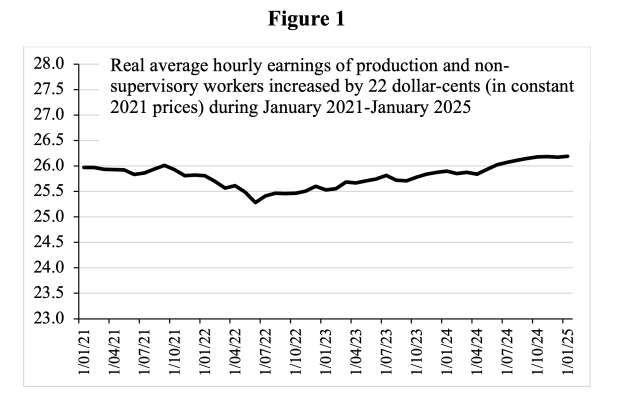
Source: Authors’ calculations based on FRED database. Nominal hourly earnings were deflated using the CPI.
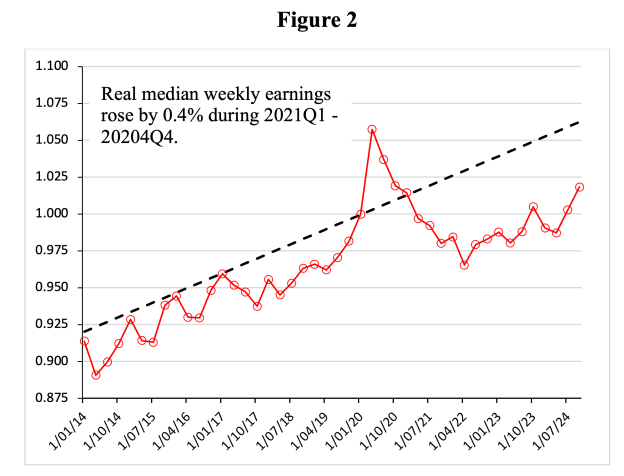
Source: Authors’ calculations based on FRED database. Nominal median weekly usual earnings were deflated using the CPI.
In America’s ever deepening dual economy, most citizens struggle to afford more than the basics and feel exhausted by the persisting financial stress. But, as the WSJ writes, “the well-off are spending with abandon. The top 10% of earners—households making about $250,000 a year or more—are splurging on everything from vacations to designer handbags, buoyed by big gains in stocks, real estate, and other assets. Those consumers now account for 49.7% of all spending, a record in data going back to 1989, according to an analysis by Moody’s Analytics. Three decades ago, they accounted for about 36%.”
A separate Moody’s Analytics report that Zandi himself issued at virtually the same moment echoes the importance of the wealth effect in explaining the strength of consumer demand and economic growth but cites statistics on spending by the top 20% of the income quintile instead. We have minor reservations about details of both sets of estimates. But none of our reservations add up to anything material. The latest data in the longer Moody’s piece extend to the same period as our last investigation. While neither Moody’s nor the Wall Street Journal ever directly make the crucial final conclusion, the linkage is clear: Yes, consumer demand by America’s most affluent citizens is indeed driving consumer spending, and consumer spending, in turn, is the main force keeping inflation so high.
The CPI inflation jumped in January 2025 — rising by 3% during the 12 months that ended in January and drifting away from the Federal Reserve’s inflation target of 2%. The Fed finds itself in a fix. On the one hand, it cannot lower the interest rate (as President Trump would like it to do), because the wealth bonanza enjoyed by the richest 10% is still fueling spending and inflation, while the majority of Americans have a hard time scraping by. It is perhaps oddly appropriate that a regime so intertwined with unelected billionaires is kept afloat by the spending of the super-affluent.
On the other hand, monetary tightening or any other shock that leads to a stock market selloff or decline in home values would rattle the confidence of the top 10%, cause them to cut back spending and hurt the economy. This may bring down inflation, but the collateral damage would be substantial.
The implication is that the Trump administration has a tiger by the tail. Waiving some qualifications, since after all, unilateral tariffs by the US would be one offs, unless they lead to escalating tariff wars, it is easy to understand why fears of still higher inflation are so pervasive. The Moody’s data provide further confirmation that wealth-price inflation, not any phantom wage-price spiral, is a powerful force running in the background as the administration sorts out its policies on tariffs and other issues.
https://www.nakedcapitalism.com/2025/03 ... -time.html
Color 'red' added for emphasis. What I bin talkin' about, this '1%' bullshit is a petty booj dodge. Fuck those people, they support the status quo by every means at their disposal and proportionally more so than their 'betters'.
